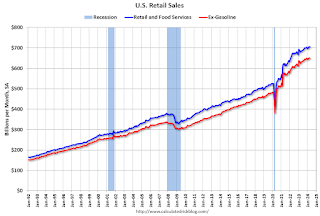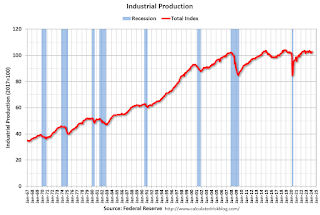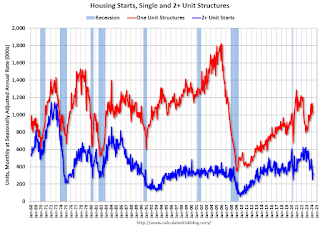by Calculated Risk on 6/17/2024 02:15:00 PM
Monday, June 17, 2024
Comparing the Current Housing Market to the 1978 to 1982 period
Today, in the Calculated Risk Real Estate Newsletter: Comparing the Current Housing Market to the 1978 to 1982 period
A brief excerpt:
In March 2022, I wrote: Housing: Don't Compare the Current Housing Boom to the Bubble and BustThere is much more in the article.It is natural to compare the current housing boom to the mid-00s housing bubble. The bubble and subsequent bust are part of our collective memories. And graphs of nominal house prices and price-to-rent ratios look eerily similar to the housing bubble.
However, there are significant differences. First, lending has been reasonably solid during the current boom, whereas in the mid-00s, underwriting standards were almost non-existent (“fog a mirror, get a loan”). And demographics are much more favorable today than in the mid-00s.And I suggested we compare the current situation to the 1978 to 1982 period, and I discussed a few similarities between the periods (no comparison is perfect):
1. Demographics were similar
2. House prices increased rapidly.
3. Inflation picked up
4. The Fed raised rates to bring down inflation.
5. House payments increased sharply
Here is a review and a discussion of what this means for house prices.
LA Port Traffic Decreased Year-over-year in May
by Calculated Risk on 6/17/2024 10:57:00 AM
Container traffic gives us an idea about the volume of goods being exported and imported - and usually some hints about the trade report since LA area ports handle about 40% of the nation's container port traffic.
The following graphs are for inbound and outbound traffic at the ports of Los Angeles and Long Beach in TEUs (TEUs: 20-foot equivalent units or 20-foot-long cargo container).
To remove the strong seasonal component for inbound traffic, the first graph shows the rolling 12-month average.

On a rolling 12-month basis, inbound traffic decreased 0.4% in May compared to the rolling 12 months ending in April. Outbound traffic decreased 0.1% compared to the rolling 12 months ending the previous month.
 Usually imports peak in the July to October period as retailers import goods for the Christmas holiday, and then decline sharply and bottom in the Winter depending on the timing of the Chinese New Year.
Usually imports peak in the July to October period as retailers import goods for the Christmas holiday, and then decline sharply and bottom in the Winter depending on the timing of the Chinese New Year. Housing June 17th Weekly Update: Inventory up 1.5% Week-over-week, Up 37.3% Year-over-year
by Calculated Risk on 6/17/2024 08:11:00 AM
 Click on graph for larger image.
Click on graph for larger image.This inventory graph is courtesy of Altos Research.

Sunday, June 16, 2024
Sunday Night Futures
by Calculated Risk on 6/16/2024 09:07:00 PM
Weekend:
• Schedule for Week of June 16, 2024
Monday:
• At 8:30 AM ET, The New York Fed Empire State manufacturing survey for June. The consensus is for a reading of -13.0, up from -15.6.
From CNBC: Pre-Market Data and Bloomberg futures S&P 500 and DOW futures are little changed (fair value).
Oil prices were up over the last week with WTI futures at $78.45 per barrel and Brent at $82.62 per barrel. A year ago, WTI was at $72, and Brent was at $77 - so WTI oil prices are up about 8% year-over-year.
Here is a graph from Gasbuddy.com for nationwide gasoline prices. Nationally prices are at $3.43 per gallon. A year ago, prices were at $3.55 per gallon, so gasoline prices are down $0.12 year-over-year.
By Request: Public and Private Sector Payroll Jobs During Presidential Terms
by Calculated Risk on 6/16/2024 08:21:00 AM
Note: I've received a number of requests lately to post this again, so here is another update of tracking employment during Presidential terms. We frequently use Presidential terms as time markers - we could use Speaker of the House, Fed Chair, or any other marker.
Important: There are many differences between these periods. Overall employment was smaller in the '80s, however the participation rate was increasing in the '80s (younger population and women joining the labor force), and the participation rate is generally declining now. But these graphs give an overview of employment changes.
The first graph shows the change in private sector payroll jobs from when each president took office until the end of their term(s). Presidents Carter, George H.W. Bush and Trump only served one term.
Mr. G.W. Bush (red) took office following the bursting of the stock market bubble and left during the bursting of the housing bubble. Mr. Obama (dark blue) took office during the financial crisis and great recession. There was also a significant recession in the early '80s right after Mr. Reagan (dark red) took office.
There was a recession towards the end of President G.H.W. Bush (light purple) term, and Mr. Clinton (light blue) served for eight years without a recession. And there was a pandemic related recession in 2020.
First, here is a table for private sector jobs. The previous top two private sector terms were both under President Clinton.
| Term | Private Sector Jobs Added (000s) |
|---|---|
| Biden | 14,096 |
| Clinton 1 | 10,876 |
| Clinton 2 | 10,094 |
| Obama 2 | 9,926 |
| Reagan 2 | 9,351 |
| Carter | 9,039 |
| Reagan 1 | 5,363 |
| Obama 1 | 1,907 |
| GHW Bush | 1,507 |
| GW Bush 2 | 443 |
| GW Bush 1 | -820 |
| Trump | -2,192 |
| 1After 40 months. | |
 Click on graph for larger image.
Click on graph for larger image.The first graph is for private employment only.
Private sector employment increased by 9,039,000 under President Carter (dashed green), by 14,714,000 under President Reagan (dark red), 1,507,000 under President G.H.W. Bush (light purple), 20,970,000 under President Clinton (light blue), lost 377,000 under President G.W. Bush, and gained 11,833,000 under President Obama (dark dashed blue). During Trump's term (Orange), the economy lost 2,135,000 private sector jobs.
 A big difference between the presidencies has been public sector employment. Note: the bumps in public sector employment due to the decennial Census in 1980, 1990, 2000, 2010 and 2020.
A big difference between the presidencies has been public sector employment. Note: the bumps in public sector employment due to the decennial Census in 1980, 1990, 2000, 2010 and 2020. The public sector grew during Mr. Carter's term (up 1,304,000), during Mr. Reagan's terms (up 1,414,000), during Mr. G.H.W. Bush's term (up 1,127,000), during Mr. Clinton's terms (up 1,934,000), and during Mr. G.W. Bush's terms (up 1,744,000 jobs). However, the public sector declined significantly while Mr. Obama was in office (down 263,000 jobs). During Trump's term, the economy lost 528,000 public sector jobs.
| Term | Public Sector Jobs Added (000s) |
|---|---|
| Biden | 1,5311 |
| Reagan 2 | 1,438 |
| Carter | 1,304 |
| Clinton 2 | 1,242 |
| GHW Bush | 1,127 |
| GW Bush 1 | 900 |
| GW Bush 2 | 844 |
| Clinton 1 | 692 |
| Obama 2 | 447 |
| Reagan 1 | -24 |
| Trump | -528 |
| Obama 1 | -710 |
| 1After 40 months. | |
Saturday, June 15, 2024
Real Estate Newsletter Articles this Week: Low Level of Delinquencies and Foreclosures
by Calculated Risk on 6/15/2024 02:11:00 PM
At the Calculated Risk Real Estate Newsletter this week:

• Q1 Update: Delinquencies, Foreclosures and REO
• Part 1: Current State of the Housing Market; Overview for mid-June 2024
• Part 2: Current State of the Housing Market; Overview for mid-June 2024
• 3rd Look at Local Housing Markets in May
• 2nd Look at Local Housing Markets in May
This is usually published 4 to 6 times a week and provides more in-depth analysis of the housing market.
Schedule for Week of June 16, 2024
by Calculated Risk on 6/15/2024 08:11:00 AM
The key reports this week are May Retail Sales, Housing Starts and Existing Home Sales.
For manufacturing, Industrial Production, and the NY and Philly Fed manufacturing surveys, will be released this week.
8:30 AM: The New York Fed Empire State manufacturing survey for June. The consensus is for a reading of -13.0, up from -15.6.
 8:30 AM: Retail sales for May is scheduled to be released. The consensus is for a 0.3% increase in retail sales.
8:30 AM: Retail sales for May is scheduled to be released. The consensus is for a 0.3% increase in retail sales.This graph shows retail sales since 1992. This is monthly retail sales and food service, seasonally adjusted (total and ex-gasoline).
 9:15 AM: The Fed will release Industrial Production and Capacity Utilization for May.
9:15 AM: The Fed will release Industrial Production and Capacity Utilization for May.This graph shows industrial production since 1967.
The consensus is for a 0.2% increase in Industrial Production, and for Capacity Utilization to increase to 78.6%.
All US markets will be closed in observance of Juneteenth National Independence Day
7:00 AM ET: The Mortgage Bankers Association (MBA) will release the results for the mortgage purchase applications index.
10:00 AM: The June NAHB homebuilder survey. The consensus is for a reading of 46, up from 45 last month. Any number above 50 indicates that more builders view sales conditions as poor than good.
 8:30 AM ET: Housing Starts for May.
8:30 AM ET: Housing Starts for May. This graph shows single and total housing starts since 1968.
The consensus is for 1.380 million SAAR, up from 1.360 million SAAR in April.
8:30 AM: The initial weekly unemployment claims report will be released. The consensus is for 240 thousand initial claims, down from 242 thousand last week.
8:30 AM: the Philly Fed manufacturing survey for June. The consensus is for a reading of 4.5, unchanged from 4.5 last month.
 10:00 AM: Existing Home Sales for May from the National Association of Realtors (NAR). The consensus is for 4.10 million SAAR, down from 4.14 million.
10:00 AM: Existing Home Sales for May from the National Association of Realtors (NAR). The consensus is for 4.10 million SAAR, down from 4.14 million.The graph shows existing home sales from 1994 through the report last month.
Friday, June 14, 2024
June 14th COVID Update: Weekly Deaths at New Pandemic Low!
by Calculated Risk on 6/14/2024 07:23:00 PM

| COVID Metrics | ||||
|---|---|---|---|---|
| Now | Week Ago | Goal | ||
| Deaths per Week✅ | 311 | 314 | ≤3501 | |
| 1my goals to stop weekly posts, 🚩 Increasing number weekly for Deaths ✅ Goal met. | ||||
 Click on graph for larger image.
Click on graph for larger image.This graph shows the weekly (columns) number of deaths reported.
 This appears to be a leading indicator for COVID hospitalizations and deaths.
This appears to be a leading indicator for COVID hospitalizations and deaths.Q2 GDP Tracking: 1.8% to 3.1%
by Calculated Risk on 6/14/2024 02:01:00 PM
From BofA:
Since last week,1Q GDP tracking is down from 1.6% q/q saar to 1.5% q/q saar and 2Q GDP tracking is up two-tenths to 1.8%. [June 14th estimate]From Goldman:
emphasis added
Our 2024Q2 GDP growth tracking estimate is now down to 2.1% (vs. the Atlanta Fed at 3.1%) and our 2024 Q4/Q4 GDP growth forecast is now down to 2% but still above consensus. [June 10th estimate]And from the Altanta Fed: GDPNow
The GDPNow model estimate for real GDP growth (seasonally adjusted annual rate) in the second quarter of 2024 is 3.1 percent on June 7, up from 2.6 percent on June 6. [June 7th estimate]
3rd Look at Local Housing Markets in May
by Calculated Risk on 6/14/2024 09:46:00 AM
Today, in the Calculated Risk Real Estate Newsletter: 3rd Look at Local Housing Markets in May
A brief excerpt:
The National Association of Realtors (NAR) is scheduled to release May Existing Home Sales on Friday June 21st at 10 AM ET. The early consensus is for 4.10 million SAAR, down from 4.14 million in April, and down from 4.23 million in May 2023.There is much more in the article.
...
In May, sales in these markets were down 0.6% YoY. Last month, in April, these same markets were up 7.6% year-over-year Not Seasonally Adjusted (NSA). However, there were two more working days in April 2024 than in April 2023, so seasonally adjusted, sales were down YoY last month.
Sales in all of these markets are down compared to May 2019.
...
This is a small year-over-year decrease NSA for these markets. There were the same number of working days in May 2024 compared to May 2023, so the year-over-year change in the seasonally adjusted sales will be about the same as the NSA data suggests.
...
Many more local markets to come!


